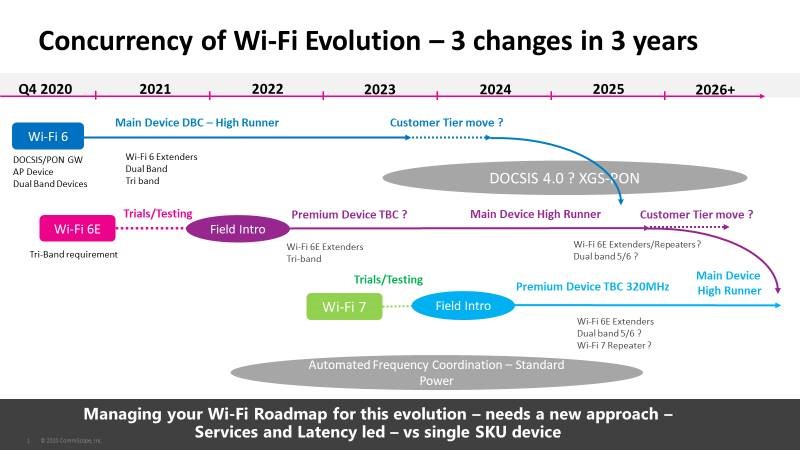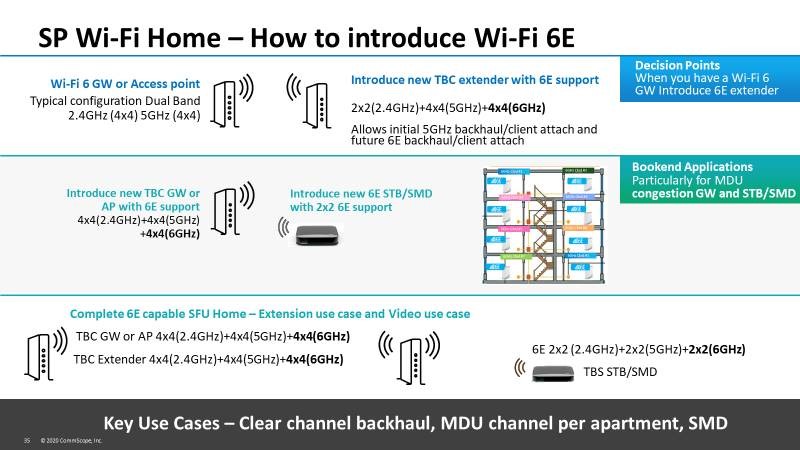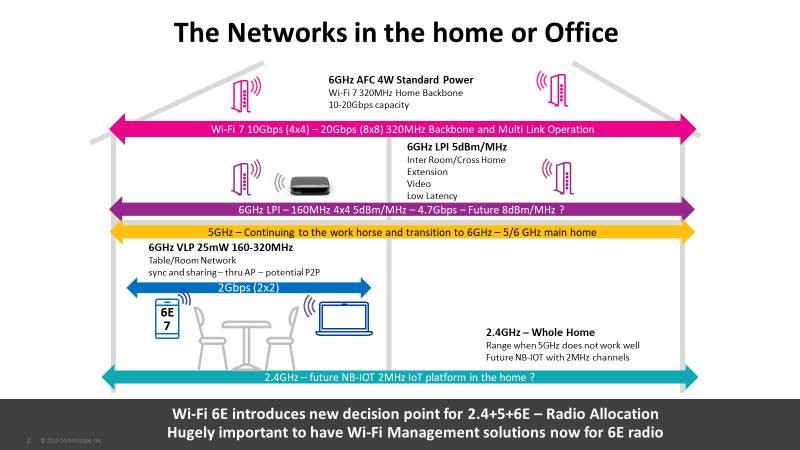 This blog first appeared in the January/February 2021 issue of Broadband Communities Magazine as a byline article.
This blog first appeared in the January/February 2021 issue of Broadband Communities Magazine as a byline article.
Service providers will be able to take advantage of three changes in Wi-Fi technology over the next three years. These important technology milestones in Wi-Fi will be introduced in quick succession:
- The availability of Wi-Fi 6 access points and clients
- The imminent availability of 6 GHz spectrum around the world and the emerging Wi-Fi 6E devices supporting it
- The finalization of Wi-Fi 7’s operating features
This is a lot for any service provider to absorb into its road map, particularly as many providers have yet to deploy Wi-Fi 6 solutions. An important step for providers is deciding how to reconcile access point and client availability in the context of new Wi-Fi technology applications over the next three years. There will also be new dynamics at play – much as there were when 802.11n introduced new 5 GHz spectrum support and the killer application was supporting IP video streaming, which still makes up more than 80 percent of all home traffic.
CLICK TO TWEET: CommScope’s Charles Cheevers showcases a service provider’s guide to the three upcoming changes in Wi-Fi.
Wi-Fi 6
Let’s start with what’s available today: Wi-Fi 6 gateways, access points and extenders. Wi-Fi 6 has been in retail for more than a year. When these access points replace previous generation Wi-Fi 5 technology, the overall performance of Wi-Fi in a home with numerous client devices (Wi-Fi 4/5/6) increases in both throughput and range. This can be attributed to many factors, including better Wi-Fi access-point designs, improvements in front-end module power amplifiers and low-noise amplifiers (i.e., better receiver sensitivity) and more efficient use of a Wi-Fi physical layer in mixed Wi-Fi environments. This performance improvement for mature applications, such as access points, meshing solutions and clients – such as IP set-tops using Wi-Fi 6 – make it the obvious choice for service providers launching new devices in 2021 to give consumers overall better home connectivity.
Wi-Fi 6E
Wi-Fi 6E is one of the most significant improvements to Wi-Fi in years, with its addition of 6 GHz spectrum. The big question is how to get it to consumers. Besides offering much needed breathing room for traffic on the 2.4 GHz and 5 GHz bands, Wi-Fi 6E provides better quality of service for users and supports new low-latency, high-speed and “bookended” services. In bookended services, the access point and the client can be deployed together on 6 GHz channels to provide congestion-free 4K and 8K video over Wi-Fi 6 GHz – even in congested 5 GHz environments. The magic of Wi-Fi 6E and 6 GHz is that only Wi-Fi 6E–capable devices can use this new spectrum, so its use accelerates the adoption of the new Wi-Fi 6E efficiency features and provides an immediate benefit to new high-speed, congestion-affected and low-latency services.
But Wi-Fi 6E comes with a unique set of hurdles:
- Regulators in each country must approve making either 1.2 GHz or 500 MHz of spectrum available to unlicensed use for Wi-Fi.
- Regulators must decide on the power levels for mobile, indoor and outdoor use of 6 GHz Wi-Fi.
- There is new complexity surrounding the introduction of tri-band 2.4 GHz, 5 GHz and new 6 GHz radios.
Wi-Fi 6E is a service provider solution that will deploy in 2022 in most countries. But even the countries that already have created the necessary regulatory agreements for 6 GHz – such as the United States, South Korea, Chile, India and the United Kingdom – will require some time to see service providers deploy 6 GHz solutions. The primary considerations for service providers include:
- What is the consumer value in this new Wi-Fi 6E solution?
- How will this value manifest itself in a service offering?
- What services can be offered in advance of general consumer electronic client churn to new 6E solutions?
Whoever can first take advantage of the almost 66 Gbps capacity in 1.2 GHz of spectrum with some key use cases and features will be well positioned to win consumers. In the case of the service provider, the key elements will be formed from the following:
- Introduction of additional tri-band Wi-Fi 6E–capable devices (beyond dual-band Wi-Fi 6 devices): There will be overlap between the deployment of Wi-Fi 6 dual-band and Wi-Fi 6 tri-band devices for several years as consumers move steadily to higher-capacity and lower-latency Wi-Fi connection needs.
- Introduction of new service provider–driven wireless home connectivity networks: These will drive the onboarding of new Wi-Fi 6E–capable clients and higher performance levels, extending the access network into the home through 6 GHz Wi-Fi and creating the determinism to the end client that only scheduled OFDMA-based Wi-Fi 6E can deliver. In other words, 6 GHz channels and Wi-Fi 6E allow the ability to schedule transmissions from 6 GHz–capable clients so they don’t collide and can be received at a “deterministic” agreed time value. Today’s Wi-Fi access point equipment has somewhat best effort – versus guaranteed – bandwidth. The advent of 6 GHz and scheduled Wi-Fi capabilities in Wi-Fi 6 can offer a guarantee – or determinism – of packet delivery. This, for example, enables gamers to be offered guaranteed performance levels on a 6 GHz Wi-Fi channel. It also enables more-effective support for new latency-sensitive applications, such as cloud gaming over Wi-Fi.
- Introduction of key service provider bookended device solutions:
- Wi-Fi 6E–based mesh solution: Use Wi-Fi 6E to guarantee backhaul capacity and maximize the potential of 5 GHz for LAN connect only. At the same time, use the 6 GHz backhaul capacity to also directly attach to sparse 6E clients as they emerge gradually in the home. Though 6E clients will start replacing Wi-Fi 6 rapidly, because of the higher cost, there will be a mix of three sets of Wi-Fi devices: low-cost Wi-Fi 5–only devices, dual-band Wi-Fi 6, and tri-band 6E clients shipping together for the next three years. After this three-year period, Wi-Fi 7 comes into the mix.
- Wi-Fi 6E–based set-top box (STB) and smart media device (SMD) solutions: Particularly in congested 5 GHz multiple-dwelling-unit (MDU) deployments, using new 6 GHz spectrum can afford apartment residents their own Wi-Fi channels, offering unparalleled performance for service provider–led SMD solutions. What OTT streaming service wouldn’t want to run on a device with no congestion in its delivery?
- First deterministic, low-latency, no-jitter Wi-Fi services: Wi-Fi 6E can deliver connection quality equivalent to an Ethernet cable. The 6 GHz spectrum offers a new platform for low-latency, no-jitter applications, such as gaming and financial trading. In addition, high-capacity services such as virtual reality and augmented reality will need Wi-Fi 6E to create in-room, untethered, immersive experiences that can work only with determinism of rendering and decode times.
Wi-Fi 6E–based service-provider offerings align more with new use cases and new services, solving issues such as MDU 5 GHz congestion. These deployments run concurrently with Wi-Fi 6 gateway and access-point deployments for consumers not quite ready to take advantage of the new features aligned with Wi-Fi 6E. We expect to see service providers drive 6E adoption faster than the random addition of Wi-Fi 6E–capable clients to the home and take advantage of extending their deterministic DOCSIS 3.1 and XGS-PON access networks through the home to the end client applications.
Wi-Fi 7
There’s more … enter IEEE 802.11be or extremely high-throughput (EHT) Wi-Fi. Currently working through specification within IEEE and expected to become the Wi-Fi 7 standard, it is a rapid evolution of Wi-Fi 6E and naturally extends the work of new spectrum-aligned features. To complete Wi-Fi’s journey to try and match the capability of any wired solution, Wi-Fi 7 adds several features, but two in particular define what it is and where it will be used.
320 MHz Channels
A significant upgrade from 160 MHz support in Wi-Fi 5/6, 320 MHz stretches modulations to 4K QAM. Together with 6 GHz spectrum availability, this gives Wi-Fi the potential to support 10–20 Gbps in the home, creating the potential for both 10 Gbps-plus backbones to interconnect rooms and the ability to do in-room Wi-Fi from 4.7 Gbps to 10 Gbps, depending on investment in radios. This creates a future wireless platform to grow services such as complete, untethered, low-latency immersive solutions on headsets or even on holographic monitors, such as those from Looking Glass Factory. With this wireless platform, it’s easy to imagine the applications that will build up in the home.
Multilink/Multiband Operation
With tri-band access points and clients becoming the norm from 2023 onward, the Wi-Fi specification introduces the ability for the access point and client to send traffic on all three bands (2.4/5/6 Ghz) and for the Wi-Fi MAC itself to manage the decisions about how to send and receive these IP streams over the multiple bands. This will effectively replace the specific band steering seen today, coaxing clients to the right single band to get the best throughput.
So, although there will be potential to introduce Wi-Fi 7–based solutions in 2023, it will be driven by a need to support high-capacity applications in particular. Because most people will not need this immediately, there will be plenty of room for Wi-Fi 6E and Wi-Fi 6 solutions to find adoption and overlap with Wi-Fi 7 availability. However, Wi-Fi 7 also will re-sync the changes in Wi-Fi 6 and 6E insofar as the shift to tri-band access points and clients goes – creating compelling new Wi-Fi solutions for all deployments in the 2025 timeframe. In particular, home backbone and mesh solutions as well as VR/AR solutions will rapidly adopt Wi-Fi 7 as core technology. Also, new access technologies, such as DOCSIS 4.0, will naturally align with the availability of Wi-Fi 7 – pushing 10 Gbps low-latency delivery from the core network to client applications in homes.
The simple path for service providers
There is a simple path for service providers to take advantage of the three new changes in Wi-Fi technology over the coming three years. At its core is the key philosophy of investing in extending deterministic high-capacity and low-latency networks to client applications themselves, not just the access network. All three Wi-Fi solutions – dual-band Wi-Fi 6 and tri-band Wi-Fi 6E and 7 – will have a fundamental part in creating the new platform of reliable high-capacity, low-latency wireless networks that new home services, such as VR and AR, will run on in the future.
By investing in creating a deterministic wireless platform in homes, service providers will naturally attract all services to that platform, ensuring their relevance to consumers and potentially offering new commercial agreements with other OTT providers wanting to leverage low-latency, congestion-free wireless delivery for their services to use. It seems to be one of those times in which if the service provider builds it, they will come. And they will indeed come, as reliability, performance and latency required for the service become fundamental in the increasingly digitized world.















